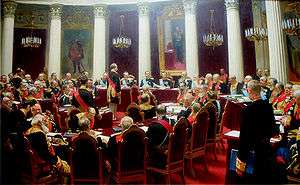Mariinsky Palace
| Mariinsky Palace | |
|---|---|
| Мариинcкий дворец | |
 The 99-metre-wide Blue Bridge spans the Moika in front of the Marie Palace. | |
| General information | |
| Town or city | St. Petersburg |
| Country | Russia |
| Coordinates | 59°55′51″N 30°18′34″E / 59.93083°N 30.30944°E |
| Completed | 1844 |
Mariinsky Palace, also known as Marie Palace (Russian: Мариинcкий дворец), was the last Neoclassical imperial palace to be constructed in Saint Petersburg, Russia. It was built between 1839 and 1844 to a design by the court architect Andrei Stackensneider.
The palace stands on the south side of St Isaac's Square, just across the 99-metre-wide Blue Bridge from Saint Isaac's Cathedral. In the 18th century, the plot belonged to Zakhar Tchernyshov and contained his mansion (1762-68), which was occasionally let to Prince of Condé and other foreign worthies visiting the Russian capital. In 1825-39, the Tchernyshov mansion housed a military school, where Mikhail Lermontov studied for two years.

Stackensneider's palace was conceived by Emperor Nicholas I as a present to his daughter Grand Duchess Maria Nikolaevna of Russia on the occasion of her marriage to Maximilian, Duke of Leuchtenberg, Eugène de Beauharnais's son. Although the reddish-brown facade is elaborately rusticated and features Corinthian columns arranged in a traditional Neoclassical mode, the whole design was inspired by the 17th-century French Baroque messuages. Other eclectic influences are apparent in the Renaissance details of exterior ornamentation and in the interior decoration, with each main room designed in a different historic style.

The Mariinsky Palace returned to imperial hands in 1884 and remained imperial property until 1917, housing the State Council of Imperial Russia, State Chancellory, and Soviet of Ministers. The grand hall for the sessions of the State Council was designed by Leon Benois in 1906. On 2 April 1902, a terrorist assassinated the Minister of Interior, Dmitry Sipyagin, in the palatial vestibule.
The Provisional Government took full possession of the palace in March 1917 and gave it over to the Council of the Russian Republic, also known as the pre-parliament. After the October Revolution, the palace housed various Soviet ministries and academies. During the German-Soviet War, it served as a hospital and was subjected to intensive bombing. The war over, the palace became the residence of the Leningrad Soviet, succeeded by the Saint Petersburg Legislative Assembly in 1994.
References
- Belyakova Z.I. Mariinsky dvorets. SPb, 1996.
- Petrov G.F. Dvorets u Sinego mosta: Mariinsky dvorets v Sankt-Petersburge. SPb, 2001.
Coordinates: 59°55′51″N 30°18′34″E / 59.93083°N 30.30944°E